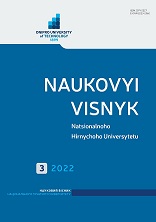

 | Наукова періодика України | 
| Naukovyi visnyk Natsionalnoho Hirnychoho Universytetu |
Sobolev V. V. Mechanism of thick metal walls penetration by high-speed microparticles / V. V. Sobolev, O. S. Baskevych, L. M. Shyman, S. M. Usherenko // Науковий вісник Національного гірничого університету. - 2016. - № 6. - С. 75-83. - Режим доступу: http://nbuv.gov.ua/UJRN/Nvngu_2016_6_11 Purpose. Analysis and estimation of physical parameters which create conditions for microparticles penetration into metal microstructure to abnormally big depth. Methodology. Quantum mechanical three-site model has been used for studying the regularities of electron motion in the field of two Coulomb centres and numerical solution for the problem of the effect of external electrical charge on stability of the chemical bond. Solution was found for the equation of heat conductivity for estimating the temperature of microparticles heating under compression and acceleration by explosively driven accelerator. Stokes's law was used for estimating viscosity of hypothetical medium which can be penetrated by microparticle at a great speed and to a great depth. The research was done with the help of X-ray microanalysis, X-ray crystallography, micrographic investigation, mass-spectrometry and electronic spectroscopy. Findings. Solution of the quantum mechanical model testifies that electric charges serve as catalysts responsible for the significant reduction of the energy barrier of chemical reactions. To ensure super deep penetration, it is necessary to achieve acceleration of a great number of microparticles in a special explosively driven accelerator. Heating, intensive stirring and friction result in electrification of the surface of the particles, which is known as triboelectric effect. The hypothesis about physical and chemical mechanism of particles penetration into metals resulting from high-speed impact has been put forward. Originality. The research has established relationship between the sizes of microparticles accelerated by explosion and the density of electric charges on their surfaces, as well as the depth of their penetration into the metal barrier. By experimental research, it was proven that maximum depth of microparticles penetration is directly proportional to the maximum density of surface charges for the particles of the 50 - 80 <$Emu>m size. It is assumed that particles penetration into metals to greater depths is conditioned by the reduction of the barrier material viscosity in the zone of particle-barrier contact due to quantum mechanical effects in the solid-state plasma. Practical value. The value of the work includes creating a new generation of metal composites as well as new prospective technologies of reactive materials utilization. Цитованість авторів публікації: Бібліографічний опис для цитування: Sobolev V. V. Mechanism of thick metal walls penetration by high-speed microparticles / V. V. Sobolev, O. S. Baskevych, L. M. Shyman, S. M. Usherenko // Науковий вісник Національного гірничого університету. - 2016. - № 6. - С. 75-83. - Режим доступу: http://nbuv.gov.ua/UJRN/Nvngu_2016_6_11.Додаткова інформація про автора(ів) публікації: (cписок формується автоматично, до списку можуть бути включені персоналії з подібними іменами або однофамільці) |
|
|
Всі права захищені © Національна бібліотека України імені В. І. Вернадського |
|||||